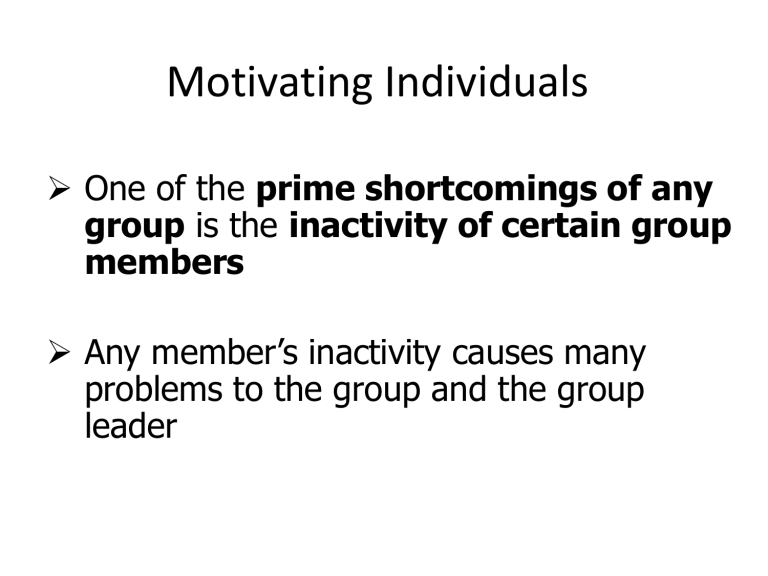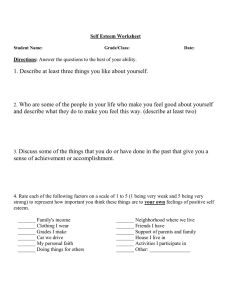
Motivating Individuals One of the prime shortcomings of any group is the inactivity of certain group members Any member’s inactivity causes many problems to the group and the group leader Problems caused by inactive members lost resources of inactive group members Less effectiveness of the group as a unit. Inactive demoralize other members Failure to participate dampens enthusiasm Result in a marked negative effect on the group. Reasons why some members are inactive They do not understand the task to be accomplished. Thy do not understand what part they are supposed to play. They do not receive sufficient motivation to move them into action. Whose fault The fault does not lie within the members. They will usually respond to the motivation they receive The fault is the leader – he needs to motivate the individuals Basic Motivational Principles Motivation is the source of all action The process that initiates, guides and maintain goal-oriented behavior. It is what causes you to act, whether it is getting a glass of water to reduce thirst It involves the biological, emotional, social and cognitive forces that initiate behavior. It is pathway to change our way of thinking, feeling and behavior. Group action is the result of motivation of the individuals within the group. Inactivity – is the results from a lack of motivation. Effects of motivation Adherence Unity confusion Indifference Basic Motivational Principles • Many times when confusion or conflict occurs within the group, it is because the leader has failed to motivate each individual within the group. • It has been rightly stated that you do not lead groups; rather, you lead the people that make up the group, each as an individual. A salesman. Salesmanship requires a great deal of individual motivation. A successful salesperson “helps” a client “discover” a “desire” for the salesperson’s product or service before closing the sale. A salesman. Salespeople who see only their own desire for making the sale (income) and do not spend adequate time relating to their prospect’s desires soon discover that they are no longer selling. As a leader • The same is true when motivating a group. • When the leader disregards the desires of the individuals within the group, he soon finds he is no longer leading. • No motivation that meet individual needs, members respond by doing nothing. As a leader There is no such thing as a group member who cannot be motivated. Every day every living person is motivated to do something. Once a person links himself emotionally with a group as a result of interest shown in his individual desires, he can be motivated to do many things that are contrary to his own personal desires in order to benefit the group. As a leader When that point is reached, he finds fulfillment in achieving for the group rather than for himself. As a leader, you must be able to get your group and its individual members moving– and keep them moving– in the desired direction. As a Leader • In attempting to motivate individuals, we need to recognize that individual needs are especially important and play a major role in determining what “gets people going”. Research Current research suggests that people usually motivate themselves by responding to their inner needs. Leaders need to understand these needs “so that as leaders we work with human nature, not against it”. Abraham Maslow In his concept of a hierarchy of needs “suggests that individual needs are arranged in order of priority” “with the stronger needs desiring satisfaction before other needs can be met”. Physiological needs These are a person’s physical needs for food shelter warmth sexual gratification and other basic body functions. Safety These include the need to feel safe from physical danger the need for physical, mental, and emotional security Social These include the need for friendships interaction with other people sense of belonging acceptance within a social circle. Esteem These needs fall into two closely related categories– “self-esteem and the esteem of others”. Esteem • Self-esteem includes our need to respect ourselves, feel personal worth, adequacy and competence. Esteem Esteem for others embraces our need for respect, praise, recognition, and status in the eyes of others. Self-actualization • The need to achieve as much as possible, to fully develop one’s gifts or potential. Two interesting points First, if one of our stronger needs is threatened, we jump back down the steps to defend it. You do not worry about status, for example, if you are starving. Therefore, if you appear to threaten people’s security by your proposed changes as a leader, you should expect a stoutly defended response. Two interesting points Second, a satisfied need ceases to motivate. “When one area of need is met, the person concerned becomes aware of another set of needs”. These in turn now begin to motivate him or her. Self-motivating As Suggested by Herzberg, • believed that the following five motivators provide satisfaction to individual needs; Achievement A sense of personal achievement in the work being accomplished and brought to a successful conclusion. A sense that one is making a worthwhile contribution to the objectives of the group. “The sense of achievement is in proportion to the size of the challenge”. Recognition Acknowledging a person’s contribution. Appreciating the work being done. Receiving adequate recognition for achievements. Interest • A feeling that the work is challenging and demanding the best from the individual. Responsibility • Being allowed to control the work being done. • Being trusted. • Having authority to make decisions and being accountable for work done. Advancement A feeling that as an individual, one is developing and advancing in experience and ability. The prospect of promotion or advancement. “Providing the right climate and opportunities for meeting these needs for each individual in the group is possibly the most difficult and certainly the most challenging and rewarding task of the group leader”. Motivating Young Adolescents Build Relationships • Provide environment. • They must believe that adults are important to them. • Be honestly supported or rejected by others as a person capable of directing his or her future behavior. • Personal encouragement– caring one-on-one relationship Be a Model • Adults whom they like and respect for their behavior and attitudes. • Adults with a development of logical reasoning Be Careful of Stereotypes • Don’t assume that early physical developers will act more maturely than peers who have yet begun to grow. • Don’t assume that physically attractive adolescents are intelligent and responsible. • Don’t assume that unattractive or overweight adolescents are undisciplined, irresponsible, or lazy. • Remain aware of what you communicate regarding your expectations of them. “We act like we are treated.” Provide Opportunities for Youth to Take Initiative • Provide activities that teach-- self-motivating. • Let them assume responsibility for shaping their environment. • Provide consistent limits for acceptable behavior. • Give them enough structure so that initiative can most likely be met. • Relinquish the amount of control they can successfully handle and appreciate. Involve Youth in Decision-making • Structure ways to give increasing amounts of autonomy • in establishing rules • in selecting and planning programs • in negotiating individual and group contracts • in selecting group rewards • in actually conducting activities • in evaluating the program • Balance youth autonomy and adult control as to capabilities of the individuals. • Allow as much control as they can manage. • Provide controls that are necessary to protect youth from harm due to their own inexperience, but reduce adult-imposed controls as young people gain experience and responsibility Make Peer Influence Positive • While peers do have an increasing influence on behavior, most adolescents retain their family values. • Can be a motivator • Make rules that govern behavior • Plan activities that require collaboration rather than competitive efforts.. • Set group goals and rewards that require cooperation. • Plan activities where the peer group receives recognition for helping or making a contribution. • Engage groups in role-playing and simulation games. • Peer counseling. • Peer tutoring Tap Young Adolescents • Desire to Make Commitments • Short-term goal or provide an honorable out. • Commitment should be of one’s own choosing. • “Choice” contributes to sense of personal autonomy. • Should be truly meaningful to them or to others. Provide Safe Opportunities for Risktaking • Risk-taking is a normal part of growing up. • Risk can help young adolescents grow, test their physical, cognitive, and social skills against reality and feel good about themselves. • Risk provides challenge. As long as the situation is not too threatening, risk-taking provides help in motivating, is constructed to promote selfesteem, and protects them from physical or emotional harm




